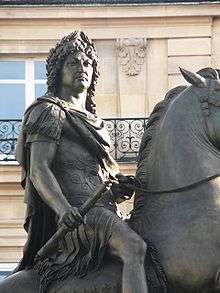Treaties of Nijmegen
| Négotiations de la Paix de Nimègue (French) | |
|---|---|
 The Place des Victoires in Paris, with an equestrian statue of Louis XIV, was designed as a memorial to the Peace of Nijmegen. | |
| Context | Franco-Dutch War: Franco-Dutch War end; France control Franche-Comté, select Flanders cities, and Hainaut. |
| Signed | 1678–79 |
| Location | Nijmegen, Dutch Republic |
| Parties | |
The Treaties of Peace of Nijmegen (French: Négociations de Nimègue or Traité de Nimègue; German: Friede von Nimwegen) were a series of treaties signed in the Dutch city of Nijmegen between August 1678 and December 1679. The treaties ended various interconnected wars among France, the Dutch Republic, Spain, Brandenburg, Sweden, Denmark, the Prince-Bishopric of Münster, and the Holy Roman Empire. The most significant of the treaties was the first, which established peace between France and the Dutch Republic, and placed the northern border of France in very nearly its modern position.[1]
Background
The Franco-Dutch War of 1672–78 was the source of all the other wars that were ended formally at Nijmegen. Separate peace treaties were arranged for conflicts like the Third Anglo-Dutch War and the Scanian War, but all of them had been directly caused by, and form part of, the Franco-Dutch War. England initially participated in the war on the French side, but withdrew in 1674 in the Treaty of Westminster.
Peace negotiations had begun as early as 1676, but nothing was agreed to and signed before 1678. These treaties did not result in a lasting peace. Some of the countries involved signed peace deals elsewhere, such as the Treaty of Celle (Sweden made peace with Brunswick and Lunenburg-Celle), Treaty of Saint-Germain (France and Sweden made peace with Brandenburg) and Treaty of Fontainebleau (France dictated peace between Sweden and Denmark-Norway).
Treaties signed in Nijmegen
- 10 August 1678 – France and the Dutch republic made peace. Sweden was not part of the treaty, but a paragraph in the treaty forced the Dutch Republic to take a neutral approach toward Sweden, with whom they had been at war since 1675.
- 19 September 1678 – France and Spain made peace.
- 26 January 1679 – France made peace with the Holy Roman Empire.
- 26 January 1679 – Sweden made peace with the Holy Roman Empire.

- 19 March 1679 – Sweden made peace with the Prince-Bishopric of Münster. The treaty also called for all of Münster's soldiers in Danish war-service to be withdrawn.
- 2 October 1679 – Sweden made peace with the Dutch Republic.
Terms
The Franco–Dutch War ended with a treaty which gave France control over the region of the Franche-Comté.[2] France also gained further territories of the Spanish Netherlands, adding to those it had annexed under the 1659 Peace of the Pyrenees and 1668 Treaty of Aix-la-Chapelle. These included the town of Saint-Omer with the remaining northwestern part of the former Imperial County of Artois; the lands of Cassel, Aire and Ypres in southwestern Flanders; the Bishopric of Cambrai; and the towns of Valenciennes and Maubeuge in the southern County of Hainaut.
In turn, the French king ceded the occupied town of Maastricht and the Principality of Orange to the Dutch stadtholder William III. The French forces withdrew from several occupied territories in northern Flanders and Hainaut.
Emperor Leopold I had to accept the French occupation of the towns of Freiburg (until 1697) and Kehl (until 1698) on the right bank of the Rhine.
Culture
Marc-Antoine Charpentier wrote a Te Deum for this occasion. The prelude of the Te Deum is also known as the Eurovision Song Contest theme.
References
- ↑ Nolan, Cathal J (2008). Wars of the age of Louis XIV, 1650–1715. ABC-CLIO. p. 128. ISBN 0-313-33046-8. Retrieved 8 December 2010.
- ↑ Horne, Alistair (2004). La Belle France. Vintage. p. 164. ISBN 978-1-4000-3487-1. Retrieved 7 December 2010.